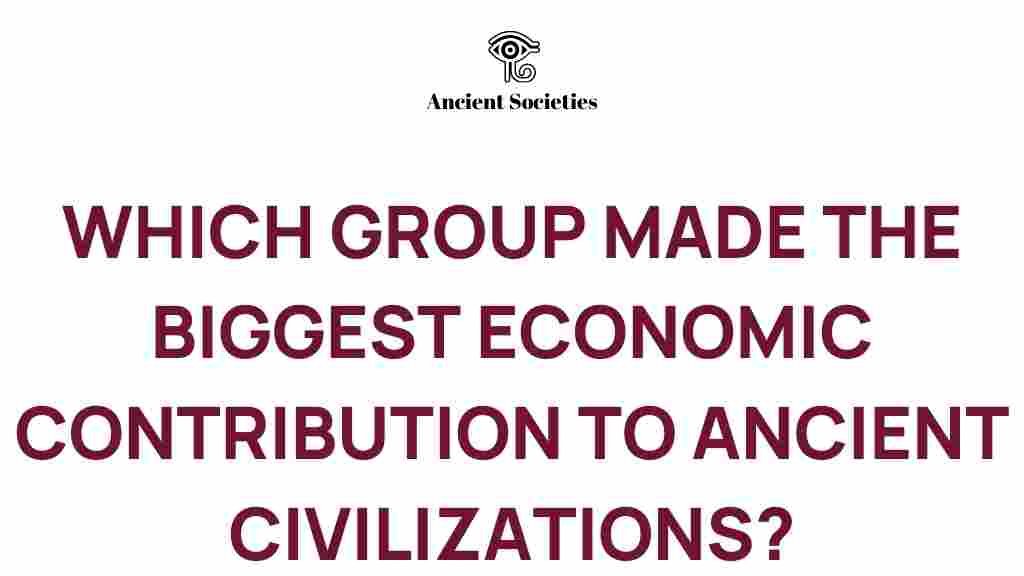Unraveling the Economic Powerhouses of Ancient Civilizations
Throughout history, ancient civilizations have played a pivotal role in shaping the world we know today. Their economic contributions were multifaceted, influencing not only their own societies but also the cultures and economies of those around them. This article delves into the economic powerhouses of ancient civilizations, exploring their trade networks, cultural exchange, societal development, agricultural innovations, empire building, and wealth distribution.
The Role of Trade Networks in Ancient Civilizations
Trade networks were the lifeblood of ancient economies. They facilitated the exchange of goods, ideas, and technologies, fostering connections between distant lands. Some notable examples include:
- The Silk Road: This famous network connected China with the West, enabling the exchange of silk, spices, and precious metals.
- The Incense Route: Linking Arabia with the Mediterranean, this route was crucial for the trade of frankincense and myrrh.
- The Trans-Saharan Trade: This network connected sub-Saharan Africa with North Africa, facilitating the trade of gold, salt, and slaves.
These trade networks were essential for the economic contributions of ancient civilizations, as they not only provided access to resources but also encouraged cultural exchange and the spread of innovations.
Cultural Exchange: The Heart of Economic Development
Cultural exchange was another significant aspect of ancient trade networks. As merchants and travelers moved from one region to another, they carried with them not just goods but also ideas, technologies, and cultural practices. This exchange had profound effects on societal development:
- Technology Transfer: Innovations such as irrigation techniques and metallurgy spread across civilizations, enhancing agricultural productivity and craftsmanship.
- Religious and Philosophical Ideas: The movement of people facilitated the spread of religious beliefs and philosophical ideas, influencing societal values and governance.
- Art and Literature: Cultural exchange enriched art and literature, leading to the creation of iconic works that reflected the shared experiences of humanity.
These interactions not only improved economic conditions but also fostered a sense of unity among diverse peoples.
Agricultural Innovations: The Foundation of Economic Power
Agricultural innovations were fundamental to the economic success of ancient civilizations. The ability to produce surplus food enabled societies to grow and thrive. Key innovations included:
- Crop Rotation: This technique maximized land use and increased yields, allowing populations to flourish.
- Irrigation Systems: Civilizations like the Mesopotamians developed complex irrigation systems that transformed arid land into fertile agricultural zones.
- Selective Breeding: The domestication of plants and animals led to more resilient and productive varieties, further enhancing agricultural output.
These advancements not only supported population growth but also laid the groundwork for trade networks, as surplus goods could be exchanged for other essential resources.
Empire Building and Economic Contributions
Empire building was a common feature of many ancient civilizations, driven by the desire for resources, trade routes, and strategic advantages. The economic contributions of these empires were significant:
- Infrastructure Development: Empires invested in roads, ports, and cities, enhancing trade and commerce.
- Taxation Systems: Efficient taxation allowed for the redistribution of wealth, funding public projects and military endeavors.
- Monetary Systems: The introduction of coins standardized trade, making transactions simpler and more efficient.
As these empires expanded, they integrated diverse cultures and economies, leading to increased wealth and economic complexity.
Wealth Distribution: The Double-Edged Sword
Wealth distribution in ancient civilizations varied widely, often reflecting the social structures and values of the time. A few key points to consider include:
- Elite Classes: Many societies had a ruling elite that controlled vast wealth, often leading to significant disparities between rich and poor.
- Trade Guilds: In some civilizations, trade guilds emerged, allowing merchants to organize and protect their interests, which could influence wealth distribution.
- Social Mobility: Certain societies provided opportunities for individuals to rise through the ranks based on merit, contributing to a more dynamic economy.
Understanding wealth distribution is crucial for comprehending the broader economic landscape of ancient civilizations.
Step-by-Step Process: How Ancient Economies Flourished
The flourishing of ancient economies can be traced through a systematic process:
- Agricultural Surplus: Innovations in farming led to increased food production.
- Population Growth: Surplus food supported larger populations, resulting in urbanization.
- Development of Trade Networks: Cities became hubs for trade, connecting various regions.
- Cultural Exchange: The movement of goods facilitated the exchange of ideas and technologies.
- Empire Building: Successful trade and wealth led to the expansion of empires.
- Wealth Distribution: As economies grew, wealth distribution patterns emerged, influencing social structures.
This process highlights the interconnectedness of agricultural innovations, trade, cultural exchange, and societal development.
Troubleshooting Tips for Understanding Ancient Economies
When studying the economic contributions of ancient civilizations, consider the following tips:
- Contextual Understanding: Always place economic activities within the broader historical and cultural context.
- Comparative Analysis: Compare different civilizations to identify unique economic practices and contributions.
- Interdisciplinary Approach: Incorporate insights from archaeology, anthropology, and history for a comprehensive view.
By following these tips, researchers can gain a deeper understanding of the complexities of ancient economies.
Conclusion
In conclusion, ancient civilizations were true economic powerhouses that laid the foundation for modern society. Their economic contributions through trade networks, cultural exchange, agricultural innovations, empire building, and the dynamics of wealth distribution continue to influence our understanding of economics today. By studying these aspects, we not only unravel the mysteries of the past but also gain insights into the forces that shape our current world.
For more information on ancient trade networks and their impact on modern economies, check out this resource. Additionally, for deeper insights into societal development, you can visit this link.
This article is in the category History and created by AncientSocieties Team
